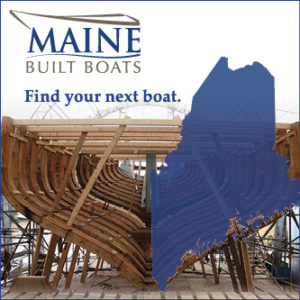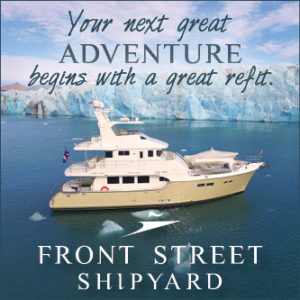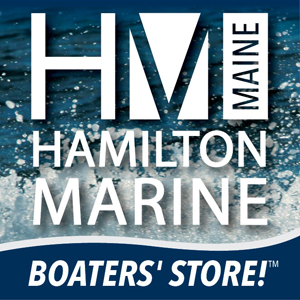By Sheila Dassatt
Over the past few months, I have had various suggestions of a topic for my article. This particular one keeps coming back to me, so I thought I’d “give it a go.” How many fishermen prefer one side or the other for hauling their traps?
It was said that some fishing communities have mostly starboard or right side haul. Then you go to other fishing communities and they are mostly port or left side haul. The question that was asked of me is “why is that?” Well, that is a good and interesting question to some of us. Let’s find out.
How far back in time do we want to go with this? Here is how the terms originated: The term starboard came from the use of a specialized steering oar which was used before ships had rudders. The oar was held by an oarsman located in the stern of the ship. There were many more right-handed sailors than left-handed sailors. This meant that the steering oar was affixed to the right side of the ship. The word starboard comes from Old English steorbord, literally meaning the side on which the ship is steered, descendant from the Old Norse words styri meaning “rudder” (from the verb styra, literally “being at the helm,” having a hand in) and Boro meaning etymologically “board”, the “side of a ship.” Port (left). Port is derived from the practice of sailors mooring ships on the left side at ports in order to prevent the steering oar from being crushed.
As years moved forward, this explanation comes from the direction of the prop, if it moves to the left or the right. If it rotates to the right, it thrusts the vessel to the left. If it rotates to the left, it rotates the vessel to the right. This is very important when you are coming into port. I must admit, this has become an interesting research project. I have asked various people about this such as my daughter, Christy who took the tugboat small vessel course at Maine Maritime Academy. She was pleased that she remembered the reasons for port or starboard. I asked Mike who operates our vessel F/V Saving Grace and also talked about the Rules of the Road, telling me that when you are facing a vessel that is coming your way, they are to pass port to port. If you have a port side vessel, you can see one another more accurately. I remember going with my Dad who was a tugboat captain for Holmes in Belfast during the sixties and seventies. I do remember that the thrust of the tug pushed to the left or port side when approaching a ship. Of course, this depended on the dock that the ship was going into. I just took these things for granted until now!
Getting back to the fishing vessel side of this, Mike said that Dave Wiberg was telling him that they used to go lobstering and haking. This was so interesting that I also asked Hilton Turner who said the same theory. Said his grandfather used to haul lobsters and go haking as well. They actually could haul from both sides of the boat. He also said that according to Family Tradition, his grandfather hauled port side and taught the next generation the same way and so on from there. So this is one explanation and a good one.
It was also said that a lot of factors have to do with the direction of the wind even in various ports. In places like Boothbay and Harpswell, they are mostly starboard side haul which has a lot to do with the direction that the wind primarily goes in even when they are on the mooring. It was noticed that a lot of fishing vessels are port side when you come east such as Stonington and Jonesport area. This is the same scenario, according to wind direction, also for coming into port to sell your lobsters and your daily catch.
Here’s another theory, which I was honestly told because I’ve seen it. One fisherman had a port side haul boat and over the years, the leg and knees, shoulder, etc. were starting to wear out over time. So when they had their next boat built, it was switched to the starboard side to allow for the body getting “worn out” on the other side of the boat! Now this is a true story, but it also shows just how hard the fishermen work and adjust their boats so they can keep going.
There is always some slang that goes with these theories among the fishermen. There is the one “left is best” and “right is wrong.” These are just some of the sayings that are sent back and forth when we start evaluating which side is the best!
From the boat building side of it, when a fisherman is having their boat built, they choose the hauling side that they want built into the boat right from the beginning. When we had ours built, she was a starboard side boat, because that’s what my Dad did and his father before him, Family Tradition again. When we fished out of F/V Sari Ann, she is a port side boat and we adapted to it fairly well. We have had an opportunity to try both sides and have an advantage in different ways such as when you’re steaming home, the wind and spray may be going in a certain direction. Depending on which side of the boat is more open to the elements, it shows the side that works the best for our geographical home port. I have a tendency to hunker down on the side that the wind and spray isn’t blowing in on me. This makes perfect sense.
I have found this to be more interesting than I thought it would be and I’m glad that it was brought to my attention. When I was asked about it, I wasn’t sure if there was enough information to write about. This proved that there is quite a lot of different reasons for choosing port or starboard. A lot of the reasons also have to do with The Rules of the Road, which I can’t stress enough that we should all know if we’re going to be out on the open seas.
Please feel free to bring topics to me that you have questions about. I’m happy to dig into it! Take care and be safe out there.



